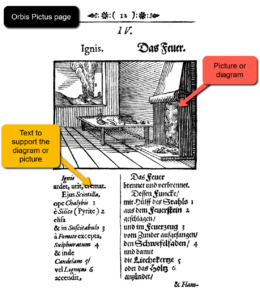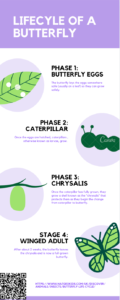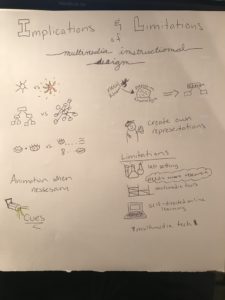Chapter 7: The Multimedia Principle
Butcher describes the Multimedia Principle as the “finding that learning with words and pictures is more effective than learning with words alone” (p.174). This principle also provides justification and context for researching “when, how, why, and under what conditions” other multimedia principles may help or hinder one’s learning and it unveils the criteria for creating effective multimedia learning materials (Butcher, p.174-175). Originally, the principle was “focused on text combined with (static or animated) illustrations” while today, it refers to “learning supported by varied forms of visual and verbal content when presented in combination” such as narration with graphs, photographs, diagrams, and charts (Butcher, p.174-175). When choosing or creating an impactful multimedia tool, diagrams (abstract and/or concrete) have been found to, when supplemented by accompanying verbal content, “[facilitate] the development of accurate mental models, [enhance] knowledge integration, better knowledge application and [enable] superior [knowledge] transfer” (Butcher, p.181-183).

Photo by Dennis Scherdt on Unsplash
The Multimedia Principle helps students understand difficult topics—a study by Clinton et al. found that when undergraduate students studying complex probability have access to resources with text accompanied by relevant visuals, they “develop a verbal mental model” through “deeper processing of the text” and a “visual mental model” that makes them “more likely to make connections among different ideas” (p.579-581).
An aspect of cognitive learning that supports and helps explain the Multimedia Principle’s success is the Dual Coding Theory (Butcher, p.193). This theory demonstrates how the human brain stores audio and imagery information in two different “short-term channels” that work together to summarize concepts before transporting them to long term memory (MacMahon, 2013). In EDCI 337, both the Multimedia Principle and the Dual Coding Theory are present in our H5P Toolkit creations, annotations, Canva’s, and sketchnotes through their uses of verbal and visual content in tandem to engage, motivate and encourage knowledge recall and transfer.
Research
Many lab-based studies have been conducted on the effects of the Multimedia Principle. Mayer & Anderson (1992) found the combination of narration and animation to facilitate learning (Butcher, p.177). Mayer & Anderson’s ideas in multimedia led to the creation of modality, voice, and image principles (Mayer, 2014). In 1993, Hegarty & Just found students learn more thoroughly through the combination of diagrams and text: their findings emphasize the effectiveness of diagrams which was the first form of multimedia (The “Orbis Pictus”) that is also still used ubiquitously today (Comenius & Bardeen & Hoole, 1887). Cuevas, Fiore, & Oser supported this, with their own research on the use of diagrams for teaching the principles of flight (Butcher, p. 177).

Click here for a closer look at the Orbis Pictus annotation!
In 2004, Rieber, Tzeng, & Tribble found that incorporating interactive models into multimedia lessons supports learning (Butcher, p. 177). Models such as erosion displays, gravity examples, and DNA manipulatives allow students to experience abstract topics in a more tangible way. Videos like Crash Course, which teach a concept through animated scenes and moving diagrams, display this idea through supporting their lectures with animations and moving diagrams.
In these studies, the methods of testing remain uniform. Butcher reveals how research in multimedia assesses learning outcomes through “[memory/retention tests] for instructional materials” and “tests of deeper understanding” such as “transfer tests” and “mental models” of instructional materials (p. 179). These tests have been found to prove how multimedia lessons create better outcomes in deeper understanding tests (short answer & inference) than memory tests(multiple-choice, matching, true/false) (Butcher, p.179).
With ever-changing technologies, Butcher states technology’s role in multimedia instruction is under-researched. For this reason, teachers must make informed decisions on whether to use a technological multimedia tool. Alsadhan et al. maintain that the “successful delivery of e-learning” relies on the “design, development and implementation of high-quality multimedia content” (2014, p.26). When more multimedia technology research is conducted, educators can fine-tune their tools and techniques to create lessons supported by research.

Photo by Eco Warrior Princess on Unsplash
Graphics and Visuals
Furthermore, Butcher discusses the effects of visuals on the learner, and how different learning  objectives require different visual formats. Initially, the purpose of static illustrations is examined and it is found that “adding static diagrams or illustrations to a verbal (text or audio) presentation frequently facilitates a deeper understanding of the to-be-learned material” (Butcher, p.181). An article by Kari Jabbour (2012) supports this claim by investigating the types of graphics that foster deeper levels of learning. For example, decorative graphics are often “used to inspire instructional display by adding artistic appeal or humour, but [have] no real instructional target” (Kari Jabbour, p.13). When incorporating graphics in a lesson, it is critical to eliminate unnecessary information and have an equal balance of text and visuals.
objectives require different visual formats. Initially, the purpose of static illustrations is examined and it is found that “adding static diagrams or illustrations to a verbal (text or audio) presentation frequently facilitates a deeper understanding of the to-be-learned material” (Butcher, p.181). An article by Kari Jabbour (2012) supports this claim by investigating the types of graphics that foster deeper levels of learning. For example, decorative graphics are often “used to inspire instructional display by adding artistic appeal or humour, but [have] no real instructional target” (Kari Jabbour, p.13). When incorporating graphics in a lesson, it is critical to eliminate unnecessary information and have an equal balance of text and visuals.
Moreover, Butcher discusses the evolution of dynamic visuals, and how animations in particular influence learning objectives, “animation is better for task[s] that are complex, but if a diagram can be mentally animated, this is more beneficial for the learner” (Butcher, p.184-185). Butcher discusses how animations are useful when performing procedural tasks but are not necessarily useful when attempting to retain information (p.184). This implies that depending on the learning task, the type of graphic “serves a different purpose and is best aligned with specific instructional goal[s], stages of learning… and the learner’s knowledge level” (Kari Jabbour, p.15). The article then suggests that visuals created by the learner will support a deeper level of understanding as students must process the information and apply it to something (Butcher, p.188).
The Canva and YouTube video as shown above are examples of static versus dynamic visuals. Depending on the type of learning, an educator needs to choose which visual style is better suited for an activity. Click here to get a closer look at the static visual.
Implications and Limitations of the Multimedia Principle
Butcher concludes the chapter by outlining the implications and limitations of Multimedia  Instructional Design and the importance of understanding your unique learners. Shah & Khan (2015) support this idea by stating “multimedia [tools] provide a variety of learning styles at the same time to cater to the requirements of different students” (p.350). Butcher summarizes the findings of multimedia visual and auditory stimuli options through the following benefits: simplifying visuals using well organized semantic models, integrating verbal and visual information both abstractly and concretely; using necessary animations/cues/spotlights, considering existing knowledge for connection making, and allowing students to create their own representations when possible (Butcher, p.194-195). Upon reflection on these findings, the implementation of multimedia in the classroom appears to be a viable option for student success. Through the use of multimedia tools, “learners become active participants in the teaching and learning process instead of being passive learners” (Shah & Khan, p.356).
Instructional Design and the importance of understanding your unique learners. Shah & Khan (2015) support this idea by stating “multimedia [tools] provide a variety of learning styles at the same time to cater to the requirements of different students” (p.350). Butcher summarizes the findings of multimedia visual and auditory stimuli options through the following benefits: simplifying visuals using well organized semantic models, integrating verbal and visual information both abstractly and concretely; using necessary animations/cues/spotlights, considering existing knowledge for connection making, and allowing students to create their own representations when possible (Butcher, p.194-195). Upon reflection on these findings, the implementation of multimedia in the classroom appears to be a viable option for student success. Through the use of multimedia tools, “learners become active participants in the teaching and learning process instead of being passive learners” (Shah & Khan, p.356).
Click here for a closer look at the Sketchnote!
While research on multimedia has provided great insight into helping students learn through verbal and visual means, there are some limitations to these studies. Educators must take into account the lab setting (which varies greatly from a real-life classroom), the fact that multimedia tools may need to be scaffolded, how effective self-directed online teaching is, and that multimedia in technology requires more research (Butcher, p. 195-197). As new technologies are developed, the Multimedia Principle continues to evolve. Despite its evolution, the idea that learners can benefit from more than one form of instruction (visual and verbal content in combination) remains a timeless and successful pedagogical truth.
References
Alsadhan, A. O., Alhomod, S., & Shafi, M. M. (2014). Multimedia based E-learning : Design and integration of multimedia content in E-learning.International Journal of Emerging Technologies in Learning (iJET), 9(3), 26-30. doi:10.3991/ijet.v9i3.3308
Butcher, K. (2014). The Multimedia Principle. In R. Mayer (Ed.), The Cambridge Handbook of Multimedia Learning (Cambridge Handbooks in Psychology, pp. 174-205). Cambridge: Cambridge University Press. doi:10.1017/CBO9781139547369.010
Clinton, V., Alibali, M.W., & Nathan, M.J., (2016) Learning About Posterior Probability: Do Diagrams and Elaborative Interrogation Help?, The Journal of Experimental Education, 84:3, 579-599, DOI: 10.1080/00220973.2015.1048847
Comenius, J. A., Bardeen, C. W., Hoole, C. (1887). The Orbis Pictus of John Amos Comenius. United States: C.W. Bardeen.
Kari Jabbour, K. (2012). Multimedia Principle in Teaching Lessons. Acta Didactica Napocensia, 5(4), 11-16.
MacMahon, C. (2013, January 15). Dual Coding Theory & Multimedia Learning. [Video file]. https://vimeo.com/57440483
Mayer, R. E. (Ed.). (2014). The Cambridge Handbook of Multimedia Learning(2nd ed.). Cambridge University Press. https://doi.org/10.1017/CBO9781139547369
Shah, I., & Khan, M. (2015). Impact of Multimedia-aided Teaching on Students’ Academic Achievement and Attitude at Elementary Level. US-China Education Review A, 5(5), 349-360. doi:10.17265/2161-623x/2015.05a.006
